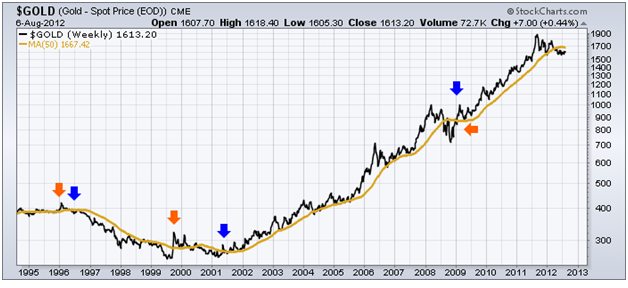A reliable signal indicates that gold is going lower.
How much lower?
This unique signal has occurred only six times in the past 15 years. The first time it “fired,” gold prices sank 28% over the course of four years.
And that wasn’t the only time this signal accurately forecasted the direction gold would move over the course of several years. Its fourth occurrence (in 2001) gave way to an eight-year trend.
What’s more, this little-known gold signal is easy to spot because it uses only two steps. Anyone can follow two steps.
Over the past two months, sellers have taken gold prices lower. Though the decline was mild, it met the criterion required to complete the first step.
Many analysts believe that gold is consolidating before another push higher. My special indicator warns of the opposite.
More frighteningly for gold prices, the second step could happen any week … and it could spark a massive sell-off.
Patient traders have been waiting since March for the second step to unfold. Given the weakness in gold, these traders may not have to wait too much longer to take action.
Once step two has completed, there is a 67% chance gold declines, perhaps for the next five years. Let me explain how to monitor step two with this chart:

This chart shows the price of GOLD along with an important resistance area for you to monitor.
To the inexperienced eye, this gold chart looks positive. However, a recent signal given in March alerted savvy traders to sell gold.
The 50-week moving average (gold line) encompasses about one year worth of price data, making it an important gauge of trend. It has also been an integral part of my two-step signal for trading gold.
Step one of this process is very basic.
First, the price of gold crosses the 50-week moving average.
The actual crossing of the moving average is a strong indicator of future movement. However, there would be too many false signals to reliably use only this criteria.
That’s why a second step was necessary.
After the 50-week moving average is crossed, the price must move in that direction long enough to form a backtest. A backtest simply implies that price comes back to kiss the 50-week moving average (not breach it) and then continues in the prior direction.
With the use of these two simple steps, traders could have achieved gains of 28%, 41% and 61% (blue arrows).
Eager traders can take a position at the point of backtest. However, the failure rate (orange arrows) increases.
By including the rules of the second step, accuracy improves, although frequency decreases. However, accuracy is much more important when determining trend.
The second step confirms that the trend has changed. That’s an important bit of knowledge since these signals can remain valid for greater than a year.
What to watch…
First, gold needs to rise back up to around $1,667 (roughly 3.5% higher).
Sellers then need to provide resistance in that area and turn gold prices lower.
Once such an action occurs, gold should stay in a negative trend until buyers can retake the 50-week average. Such a negative trend may last for many months … perhaps years.
 Facebook
Facebook
 Twitter
Twitter